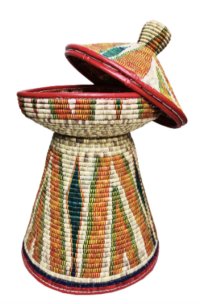Rushes are the wet ground weeds. They self seed themselves in my flower beds having escaped from around the pond.
Thing is though, they're unharmful and very useful so I always leave some to grow.
I generally use mine to make baskets, but they make decent cordage for weaving not just kishies but chairs, baskets, mats and the like too.
I came across a couple of videos to two ladies showing how the rushes were traditionally used, in two very different cultures. The first rush I can replace with our own little green field rush, and the second on is using the Loch or Lake rush, the one that has to be cut from a punt with a sickle on a long pole.
The field rushes are pulled one or two at a time. Laid flat to dry off then dampened before use.
The loch rushes are dried and then soaked, and squeezed along their length as they squeak and squeal. The resultant rush is almost leathery. Lovely stuff to work
This lady is using the fine sides of the leaves that wrap around the stems of the bullrushes/ reedmace (cattails) to make really lovely string.
I grow the mini version of the reedmace in my garden, but you can grow any of them in a bucket of water. Edible too.
This string is the kind of quality that I use to make little straw decorations, tie off bunches of lavender, etc., Makes really nice woven bracelets too.
It stays remarkably flexible and hard wearing. Doesn't do so well for stuff like boot laces though; stick to nettle for that.
This lady is using the centre of the reedmace the same way that we use the loch rush.
It's called cattail in the video and it's too pale for our loch rush, but it seems to be handling the same way.
Thing is though, they're unharmful and very useful so I always leave some to grow.
I generally use mine to make baskets, but they make decent cordage for weaving not just kishies but chairs, baskets, mats and the like too.
I came across a couple of videos to two ladies showing how the rushes were traditionally used, in two very different cultures. The first rush I can replace with our own little green field rush, and the second on is using the Loch or Lake rush, the one that has to be cut from a punt with a sickle on a long pole.
The field rushes are pulled one or two at a time. Laid flat to dry off then dampened before use.
The loch rushes are dried and then soaked, and squeezed along their length as they squeak and squeal. The resultant rush is almost leathery. Lovely stuff to work
This lady is using the fine sides of the leaves that wrap around the stems of the bullrushes/ reedmace (cattails) to make really lovely string.
I grow the mini version of the reedmace in my garden, but you can grow any of them in a bucket of water. Edible too.
This string is the kind of quality that I use to make little straw decorations, tie off bunches of lavender, etc., Makes really nice woven bracelets too.
It stays remarkably flexible and hard wearing. Doesn't do so well for stuff like boot laces though; stick to nettle for that.
This lady is using the centre of the reedmace the same way that we use the loch rush.
It's called cattail in the video and it's too pale for our loch rush, but it seems to be handling the same way.
Last edited:


